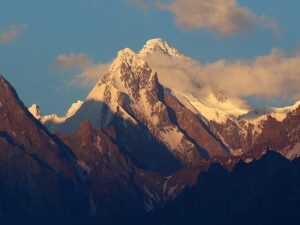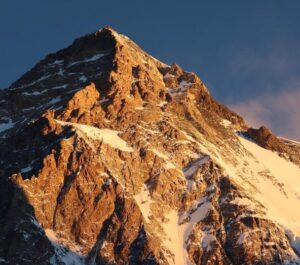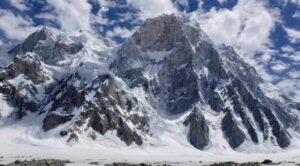The old days when 8,000m was a reliable yardstick for degree of difficulty are over. This year in particular, expeditions — and thanks to COVID, there haven’t been many — have spotlighted a trend to attempt difficult new lines at slightly lower altitudes.

Priti Wright, chilling after her first ascent of K6 Central. Photo: Expedition team
While the three climbs on 8,000’ers this year (Chinese ascents of Everest and Cho Oyu, and the Bahrain Royal Guard team on Manaslu) have featured large groups relying on massive use of ropes and O2, a handful of bold climbers in pairs or very small teams have achieved some remarkable new routes and first ascents. These include the SummitClimb team in Pakistan’s Charakusa Valley and the so-called Alpine Vagabonds, Jeff and Priti Wright, on K6.
Now this week, France’s Pierrick Fine and Symon Welfringer report from Islamabad about their first ascent of the South Face of aesthetic Sani Pakush (6,953m). Their 2,500m new line goes at M4+ WI4+, with 90-degree sections.
Here is the climbers’ report (edited for clarity), provided by Ali Sadpara.
Arrived at the beginning of October on the Toltar Glacier. We acclimatized around our base camp, situated at the foot of the massive South Face of unclimbed Sani Pakush.
After two weeks, we were ready to try this big piece of alpinism. Poor weather forced us to wait days more, but sun was then forecast for almost one week, which would give us a proper try at the face.

The South Face of Sani Pakush. Photo: Expedition team
After an early start at 2am from Base Camp on the first day, we met the first difficulties at 5,000m, at the very beginning of the face, with some sustained ice pitches. Some easier snow and mixed climbing then followed. At around 5,600m, we had one of the hardest pitches of M4+ M5 to reach a little platform and make an uncomfortable bivy.
On the second day, we managed to get high on the face and made two awesome pitches of pure ice. At around 6,200m, we looked desperately for a bivy spot but couldn’t find one. Eventually, we just perched on a rock and waited for the sun to return. On the third day, we were really exhausted after two bad bivys. We decided to set up our tent at 6,400m in a nice, comfortable crevasse on the summit ridge for a proper rest.
On October 19, we decided to make for the summit with almost no gear. We left our bivy in place and went up the last 500m on the snowy summit ridge. After seven hours of hard work through deep powder, we arrived at 2pm on the Sani Pakkush summit at 6,953m. We were completely exhausted.
We spent our last day working our way down this massive 2,500m face, alternating rappels (20-25 of them) and downclimbing. In late afternoon on October 20, we made it safely back to Base Camp, totally spent and with lots of emotions.
The mountains of Pakistan are now quiet, while options in Nepal are (relatively) open. Some teams are on Ama Dablam and the popular 6,000ers. Beyond those normal goals, the Himalaya offer uncountable virgin faces and new lines, waiting for next year, for the new trendsetters.






